Chintpurni
| Maa Chintpurni | |
|---|---|
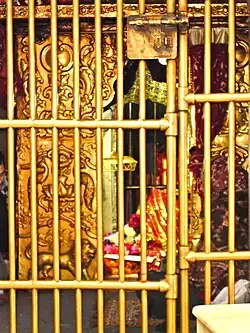 Mata Chintpurni inside from back gate | |
| Religion | |
| Affiliation | Hinduism |
| District | Una district |
| Deity | Chhinnamasta |
| Festivals | Navratri |
| Location | |
| Location | Chintpurni, 177110 |
| State | Himachal Pradesh |
| Country | India |
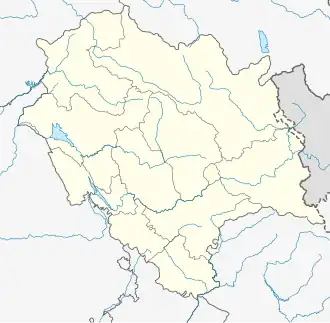 Location in Himachal Pradesh | |
| Geographic coordinates | 31°48′31″N 76°06′10″E / 31.808620°N 76.102870°E |
| Architecture | |
| Type | Hindu |
| Creator | Mai Das |
| Completed | unknown |
| Elevation | 977.87 m (3,208 ft) |
| Website | |
| http://chintpurni.in | |
Chintpurni is a small town in the Una district of Himachal Pradesh about 40 km (25 miles) north of Una, not far from the border with the Indian state of Punjab. The elevation is about 977 meters (about 3,200 feet). It is home to the Maa Chintpurni Temple which is a major pilgrimage site as one of the Shakta pithas in India. The Hindu genealogy registers at Chintpurni, Himachal Pradesh are kept here. North of Chintpurni are the western Himalayas. Chintpurni lies within the much lower Shiwalik (or Shivalik) range.
Himachal Pradesh has 5 Shakti Pithas - Chintpurni, Jwalamukhi Temple, Bajreshwari Mata Temple, Shri Chamunda Devi Mandir and Naina Devi Temple.[1][2]
The legend behind the Shakti Pitha is part of the Shaktism tradition which tells the story of the self-immolation of the goddess Sati. Vishnu had to cut her body into 51 body parts, which fell on Earth and became these sacred sites.
The legend of Chhinnamasta Devi is apparently also part of the Shaktism tradition in Chintpurni. Here, Chhinnamasta is interpreted as the severed-headed one as well as the foreheaded-one.
Ancient origin
When Lord Vishnu severed the burning body of Maa Sati into 51 pieces so that Lord Shiva would calm down and stop his Tandava, the pieces were scattered over various places in the Indian subcontinent. It is believed that Sati's feet fell at this place and is thus considered one of the most important of the 51 Shakta pithas.
The goddess residing in Chintpurni is also known by the name of Chhinnamastika. According to Markandeya Purana, goddess Chandi defeated the demons after a fierce battle but two of her yogini emanations (Jaya and Vijaya) were still thirsty for more blood. Goddess Chandi cut off her own head to quench Jaya and Vijaya's thirst for more blood.
She is usually shown holding her own severed head in her hand, drinking one stream of blood spurting from the arteries in her neck, while at her side are two naked yoginis, each of whom drinks another stream of blood.
Chhinnamasta, the headless goddess, is the Great Cosmic Power who helps the sincere and devoted yogi to dissolve his or her mind, including all the preconceived ideas, attachments and habits into the Pure Divine Consciousness. Cutting off the head suggests the separation of the mind from the body, that is the freedom of the consciousness from the material confines of the physical body.
According to Puranic traditions, Chhinnamastika Mata will be protected by Shiva – Rudra Mahadev in the four directions. There are four Shiva temples – Kaleshwar Mahadev in the east, Narayhana Mahadev in the west, Muchkund Mahadev in the north and Shiva Bari in the south – which are nearly equidistant from Chintpurni. This also confirms Chintpurni as the abode of Maa Chhinnamastika.
Chintpurni temple as a Shakta pitha
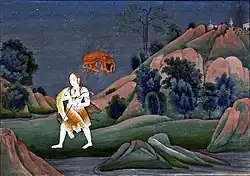
The Chinnamastika Devi is a divine embodiment of self-sacrifice and there by the Chintpurni shri is considered as a Shakta pitha. The story of Daksha yaga and Sati's self immolation is the story liked to the Shakta pithas. Shakta pithas are holy shrines of Shakti associated with a story that says about the falling of body parts of the corpse of Sati Devi, when Lord Shiva carried it and wandered in sorrow. There are 51 Shakta pithas associated with the 51 alphabets in Sanskrit. It is believed that Sati Devi's feet fell here.[3]
History
Pandit Mai Das, a Mucla (Nai caste) from Patiala Riyasat, is generally believed to have established this shrine of Mata Chintpurni in Chhaproh village about 12 generations ago (1 generation = 25 years). Over time this place became known as Chintpurni after the eponymous deity. His descendants still live in Chintpurni and perform prayers and puja at the Chintpurni temple. These descendants are the official priests at the Temple.
Hindu genealogy records
Hindu genealogy registers at Chintpurni are the genealogy registers of pilgrims maintained here by panditas.[4][5][6] Hindu pilgrimage and marriage records were also used to be kept at this holy place. The Genealogical Society (GSU) of Utah, USA has microfilmed Hindu pilgrimage records for Haridwar and several other Hindu pilgrimage centres. Priests (pandits) located at each site would record the name, date, home-town and purpose of visit for each pilgrim. These records were grouped according to family and ancestral home. The holdings by GSU include Haridwar, Kurukshetra, Pehowa, Chintpurni, Jawalapur and Jawalamukhi.[7]
Offering prayers

Devotees usually bring offerings for the Devi. Sweets (e.g. suji halwa, laddoo, barfi), kheer (sugar-coated puffed rice), patasha, coconut (or other fruits), chunni, dhwaja (red-coloured flag), flowers and ghee are some of the offerings that devotees bring. One may bring the prasad from home or may buy it from one of the shops in the bazaars of Chintpurni.
In the center of the temple is the garbha griha. The image of Mata Chintpurni is installed here in the form of a pindi (a round stone). People queue up for a darshan of the Devi and make their prayers and offerings.
The view of the Chintpurni's villages and the far flung scenic contours is enjoyable from the back-yard of the temple.
Location and transportation
Chintapurni Mata Mandir is situated 3 km West of Bharwain which lies on the Mubarkpur - Dehra - Kangra - Dharamsala Road.
Chintpurni Marg Railway Station is the nearest railway station which is about 20 km away.
Weather
In general, temperature in Chintpurni is about 5 degrees lower than in the Punjab and Haryana plains and in Delhi. The average annual rainfall is 2587 mm.[8] In 2012, it had a chilling winter as there was a snowfall, reported after a period of 52 years, leading to road jams.
| Climate data for Chintpurni | |||||||||||||
|---|---|---|---|---|---|---|---|---|---|---|---|---|---|
| Month | Jan | Feb | Mar | Apr | May | Jun | Jul | Aug | Sep | Oct | Nov | Dec | Year |
| Mean daily maximum °C (°F) | 16 (61) |
21 (70) |
24 (75) |
29 (84) |
35 (95) |
35 (95) |
32 (90) |
30 (86) |
31 (88) |
27 (81) |
22 (72) |
16 (61) |
27 (80) |
| Mean daily minimum °C (°F) | 3 (37) |
7 (45) |
14 (57) |
16 (61) |
23 (73) |
23 (73) |
22 (72) |
21 (70) |
21 (70) |
14 (57) |
9 (48) |
4 (39) |
15 (59) |
| Source: World Meteorological Organisation[9] | |||||||||||||
Accommodation

The Navaratra fairs in Shrawan (July–August), Ashwin (September–October) and Chaitra (March–April) are popular with devotees when accommodation is very tight. Other popular days are Sankranti, Purnima and Ashtami. As per the Hindu Manayata, disciples believe that on day of Ashtami on Shravan Navratri the nine jyot of other Shakta pithas were come to visit in the temple.
Gallery
-
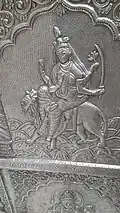 durga in the door
durga in the door -
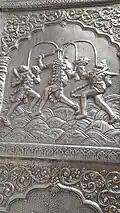 chinnamasta in the door
chinnamasta in the door -
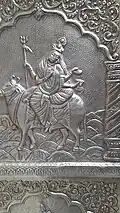 parvati
parvati -
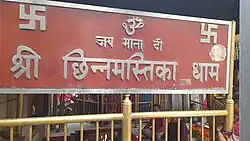 chinna masta dham
chinna masta dham -
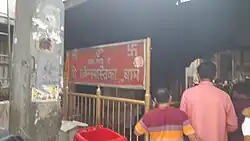 temple another view
temple another view -
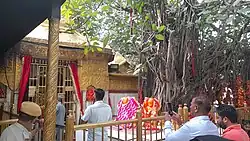 left side view
left side view -
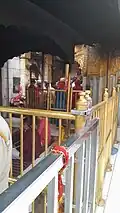 barricade
barricade -
 temple inside -side view
temple inside -side view -
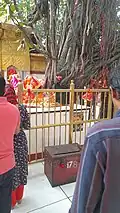 big banian tree outside
big banian tree outside
References
- ^ "Chintpurni Temple". Archived from the original on 27 January 2016. Retrieved 8 September 2018.
- ^ "Shakti Peeth In Himachal Pradesh". 28 February 2024. Retrieved 22 June 2025.
- ^ "Kottiyoor Devaswam Temple Administration Portal". kottiyoordevaswom.com/. Kottiyoor Devaswam. Archived from the original on 7 June 2013. Retrieved 20 July 2013.
- ^ Tracing your Asian roots Archived 26 April 2017 at the Wayback Machine http://www.overseasindian.in.
- ^ Hindu Pilgrimage Marriage Records Archived 30 May 2013 at the Wayback Machine http://www.movinghere.org.uk.
- ^ 10 Places Across The World That Help You Trace Your Ancestors Archived 22 February 2018 at the Wayback Machine, India Times, 29 January 2016.
- ^ "Hindu pilgrimage and marriage records – BBC News". Archived from the original on 26 January 2011. Retrieved 23 September 2010.
- ^ "Chintpurni climate: Average Temperature, weather by month, Chintpurni weather averages". En.climate-data.org. Retrieved 16 December 2021.
- ^ World Weather Information Service-Chandigarh Archived 24 December 2014 at the Wayback Machine, World Meteorological Organisation. Retrieved 29 September 2012.